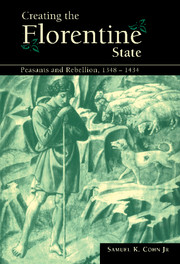Book contents
- Frontmatter
- Contents
- List of illustrations
- List of tables
- Acknowledgements
- Note on citations, dates, and measures
- Introduction
- PART I CULTURE, DEMOGRAPHY, AND FISCALITY
- PART II PEASANT PROTEST IN THE MOUNTAINS: THREE VIEWS
- 4 Peasant insurrection in the mountains: the chroniclers' view
- 5 Peasant insurrection in the mountains as seen in the criminal records
- 6 Rebellion as seen from the provvisioni
- PART III GOVERNMENTAL CLEMENCY AND THE HINTERLAND
- Conclusion
- Appendix 1 Regression models: wealth, migration, and taxes
- Appendix 2 Tax coefficients, 1354–1423
- Bibliography
- Index
5 - Peasant insurrection in the mountains as seen in the criminal records
Published online by Cambridge University Press: 07 August 2009
- Frontmatter
- Contents
- List of illustrations
- List of tables
- Acknowledgements
- Note on citations, dates, and measures
- Introduction
- PART I CULTURE, DEMOGRAPHY, AND FISCALITY
- PART II PEASANT PROTEST IN THE MOUNTAINS: THREE VIEWS
- 4 Peasant insurrection in the mountains: the chroniclers' view
- 5 Peasant insurrection in the mountains as seen in the criminal records
- 6 Rebellion as seen from the provvisioni
- PART III GOVERNMENTAL CLEMENCY AND THE HINTERLAND
- Conclusion
- Appendix 1 Regression models: wealth, migration, and taxes
- Appendix 2 Tax coefficients, 1354–1423
- Bibliography
- Index
Summary
The events in the Alpi Fiorentine and their spread across and down the northern and eastern perimeters of the Florentine state take a different shape in the judicial sources from their obscured shadows cast by the chronicles and ricordanze. First, the uprisings' temporal and geographical dimensions are much more extensive; second, the criminal records bring into question the chroniclers' assertions that the revolts were simply the rising of Florence's traditional feudal enemies assisted by a few Florentine patrician malcontents. Instead, these records show peasants as the bulk of the rank and file, part of leadership, and at times even planning military strategy.
Yet the criminal records are no less neutral than the chronicles and can no better claim to tell the whole truth. While imbrued with the ritualistic aura of notarial and juridical accuracy, they present only the state's view, tending to portray the defendants in the worse possible light even when they were absolved of their purported wrongs. The inquests report often in meticulous detail military maneuvers, the exchange of secret letters, the conversations of co-conspirators on plans to besiege castles and to overthrow lands under Florentine suzerainty. But they remain silent about the political, economic, and human motivations of the peasants who filled the long lists of the condemned for so-called conspiratorial and rebellious behavior.
By the notarial reckoning the motivation behind their “evil” was in fact not human at all but instigated by the devil (spiritu diabolico instigati).
- Type
- Chapter
- Information
- Creating the Florentine StatePeasants and Rebellion, 1348–1434, pp. 138 - 171Publisher: Cambridge University PressPrint publication year: 1999

